Having a well-stocked pantry and kitchen is essential to setting the foundation for cooking healthy meals, for you and your family. Here is a guide to get you started!
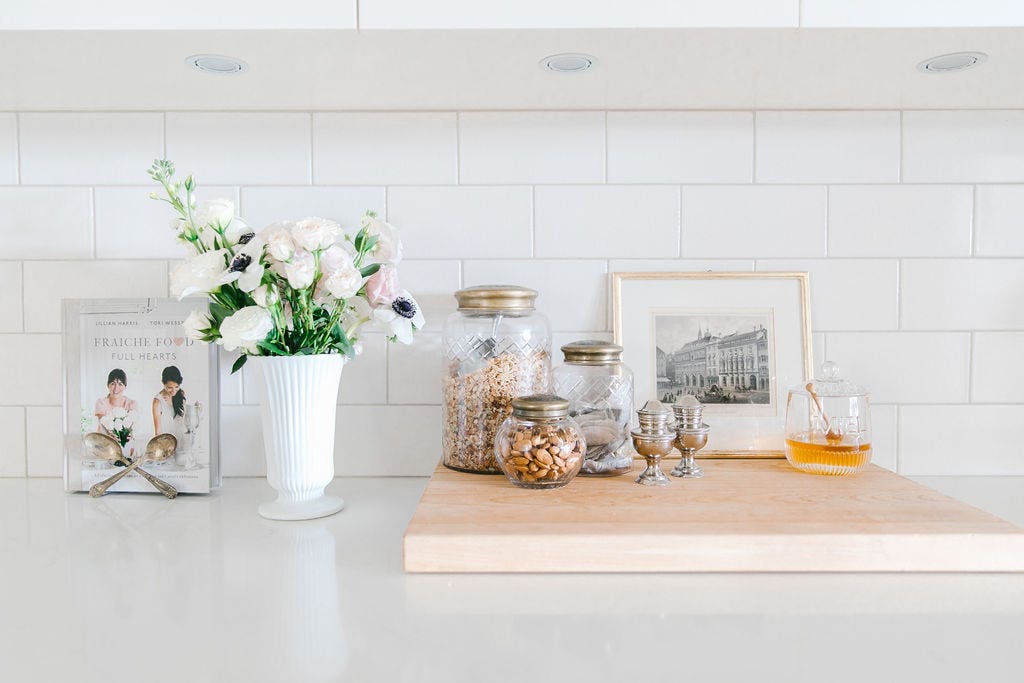
THE IMPORTANCE OF A WELL STOCKED PANTRY & KITCHEN
Simply put, cooking is faster when you have all of the ingredients. And since many foods are shelf stable and can be stocked up (where space allows), a well-stocked pantry takes the heavy lifting out of your weekly meal prep and grocery shopping (literally!).
Having essential ingredients on hand will help you be more flexible when it comes to cooking and baking on a whim, and will give you the tools to throw together a last-minute meal or baked good whenever you wish! As a Dietitian, I’ve learned through the years that healthy eating needs to be convenient – otherwise, faster food options that tend to be less healthy (and cost more) win every time! Having a well-stocked pantry filled with nutritious essentials is one of the biggest steps toward eating healthier.
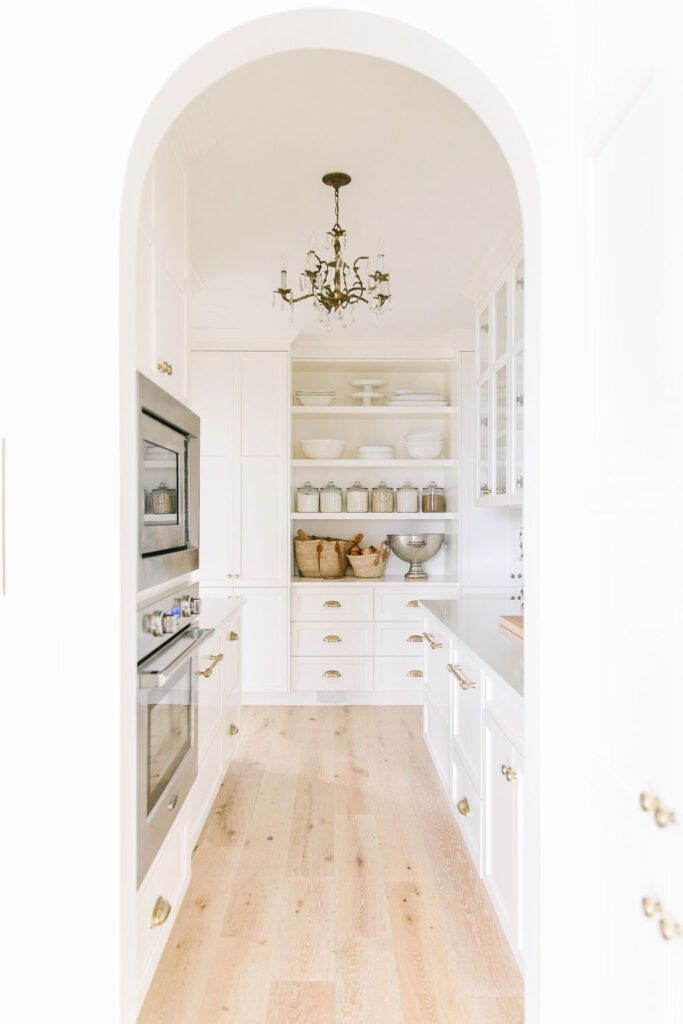
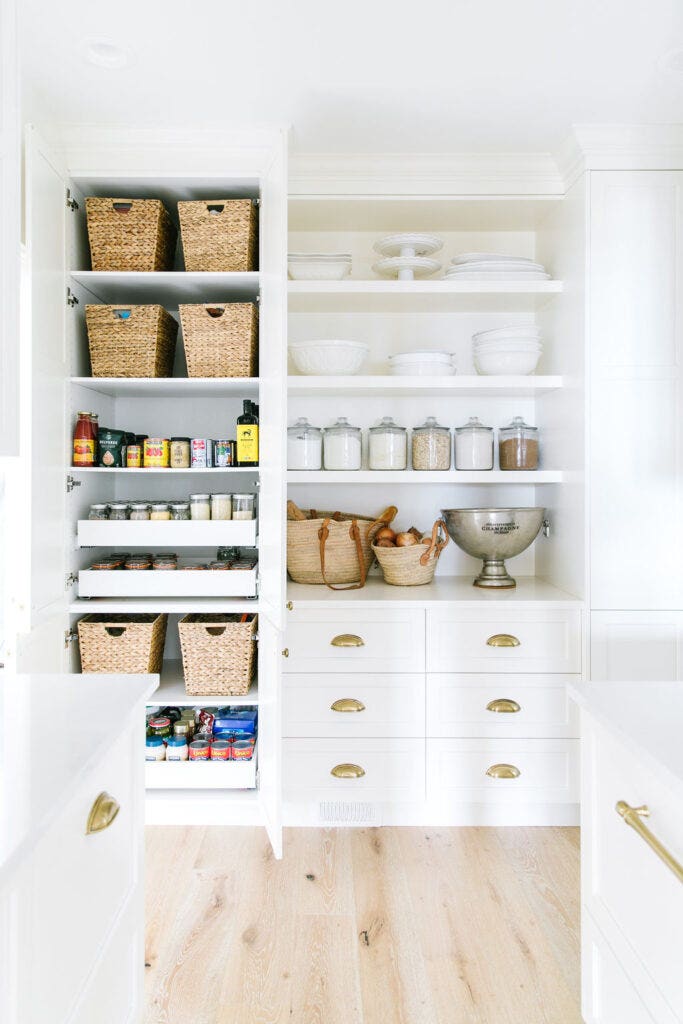
GETTING STARTED
I highly recommend assessing your current pantry situation before starting this process. Start by removing everything from your pantry, wipe it down, and note what you have. Here is a 3-part checklist:
- CLEAN: Clean out your pantry and sort it by like products. Are there items that are expired (see below for an explanation of expiry dates), stale or that you simply won’t use? Get rid of them!
- ASSESS: Do you have consistent containers that stack or fit well together? Is there room for optimizing your storage solutions to better meet your needs? How accessible are your ingredients?
- PLAN: Create a checklist (you can use the list below as your guide) for the items that you want to have on hand at all times. You can review it monthly before a big grocery shop to make sure that your pantry remains well stocked.
WHAT DO EXPIRATION DATES MEAN?
An expiration date is a date that is added to a packaged food by the manufacturer that is a suggested date by which they recommend consuming a product. It’s good to know that for most products, the expiration date has more to do with the quality of the food vs the safety. Most foods will taste best if used before that date, but will still be safe to consume after that date has passed. That being said, there are exceptions to this guideline: some foods that are more susceptible to bacterial contamination (ie: sliced deli meat) pose a food safety risk if consumed beyond this date. It’s also important to not keep high risk foods in the ‘danger zone’ (between 4-40°C) for more than 2 hours regardless of the expiration date. Many foods can be frozen before the expiration date if you can’t use them prior to that date.
HOW TO STORE PANTRY INGREDIENTS
It’s important to store your pantry ingredients properly so that they last as long as possible. Here are some useful tips:
- When using reusable bags to purchase dry ingredients, be sure to transfer them into see-through air-tight containers once you get home to retain freshness.
- If you are adding a new ingredient to a container that already has something in it be sure to empty the container out first, place the new ingredient in the jar and the ‘old’ one on top so it gets used first! The FIFO (First in First Out) rule is key here.
- For ingredients with multiple containers of the same ingredient be sure to place the ones that need to be used first in front.
- Use Mason jars or other small containers for storing baking ingredients along with any nuts or dried fruit and use smaller jars for spices. It is handy to put your baking ingredients in one section, or even in one basket, to make it easier to access when you are baking.
- Store ingredients inside cupboards or in a dark, dry and cool location to preserve them for as long as possible.
- Some products are best purchased in small amounts, such as dried herbs and spices, as they don’t have a long shelf life. Only buy things in bulk that you are going to go through quickly.
- Purchase clips for any opened bags (ie: flour) to help keep them as well-sealed as possible once opened.
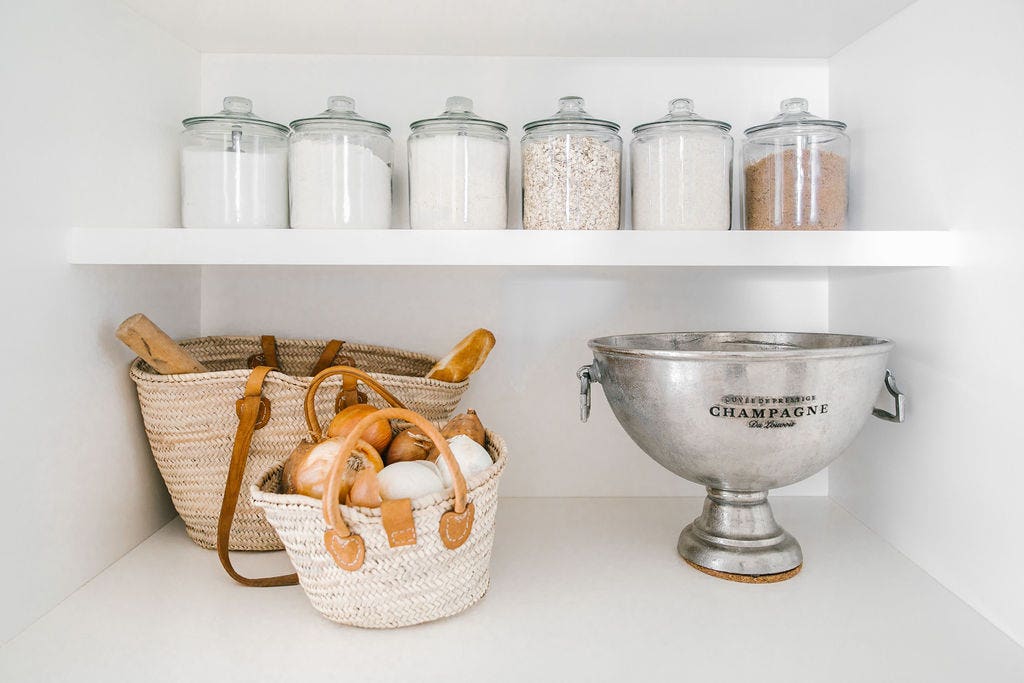
HOW TO ORGANIZE A PANTRY
Here are a few tips for organizing your pantry that will set you up for success:
- One of the keys to a well-organized pantry is accessibility. Purchase a tiered shelving insert for your cupboards is an easy way to have visibility to all of the foods in your pantry. You can remove things from their original packaging and place them into your own plastic or glass containers to make them fit better in your pantry. That way you can also see when you’re running low.
- Buy multiples of the same containers (or brands of containers) to make them easier to store.
- Use containers that you can see through (out of sight, out of mind!). All containers should have a tight seal.
- Label all of your containers; include an expiration date or the date that you purchased it.
- Combine ingredients into one jar; for instance, if you have 3 packs of cinnamon merge them into one jar (be sure to put the oldest cinnamon in last so it is used first).
- Group like items together so that they are easier to find.
- I use baskets, but you can use clear bins to organize like items like crackers fruit and nuts, baking goods or anything that isn’t used on a daily basis – be sure to label the baskets.
- Try storing all of your baked goods in a special basket so that when you bake, all you need to do is bring the basket to the counter.
- A lazy Susan can be helpful for small items.
HOW TO ORGANIZE A FRIDGE
A well-organized fridge is such a treat to open and allows you to make healthier food choices and reduce food waste. It helps save so much space which is especially important if your fridge is a compact model. I mean, it also looks so good!
- Start by removing everything from your fridge, cleaning it out with hot soapy water, and assessing your situation. Discard any items that are no longer good to use or that you won’t use in the future.
- Add additional organizers to your fridge to help maximize the space; rectangle shapes make the best use of space. Use transparent containers like hard plastic (acrylic) containers for storing things like apples, oranges, grapes etc. that may not need a lid but are hard to organize otherwise. It’s great for easy snacking and even better when the fruit is already pre washed and ready to eat!
- For the foods that need it, a container with a tight seal will help keep your food fresher for longer and being able to see inside of the container will help you keep track of what you have in the fridge and what needs to be used up.
- Use the FIFO rule: first in first out. Be sure to rotate your food and place the items that need to be used first at the front and then plan your meals around these foods.
- Section off your fridge so that similar ingredients are in the same area. Transparent plastic containers or bins are great for this as well to help you group like items such as jams or hot sauces together.
- Designate the top shelf (or any shelf) for food that needs to be used right away. I like to have one section that is dedicated for leftovers so that my family knows where to look for a quick bite to eat. Add bins to your crisper drawers to compartmentalize your produce.
- Store fresh herbs in a jar filled with a bit of water (like you would flowers) to keep them as fresh as possible.
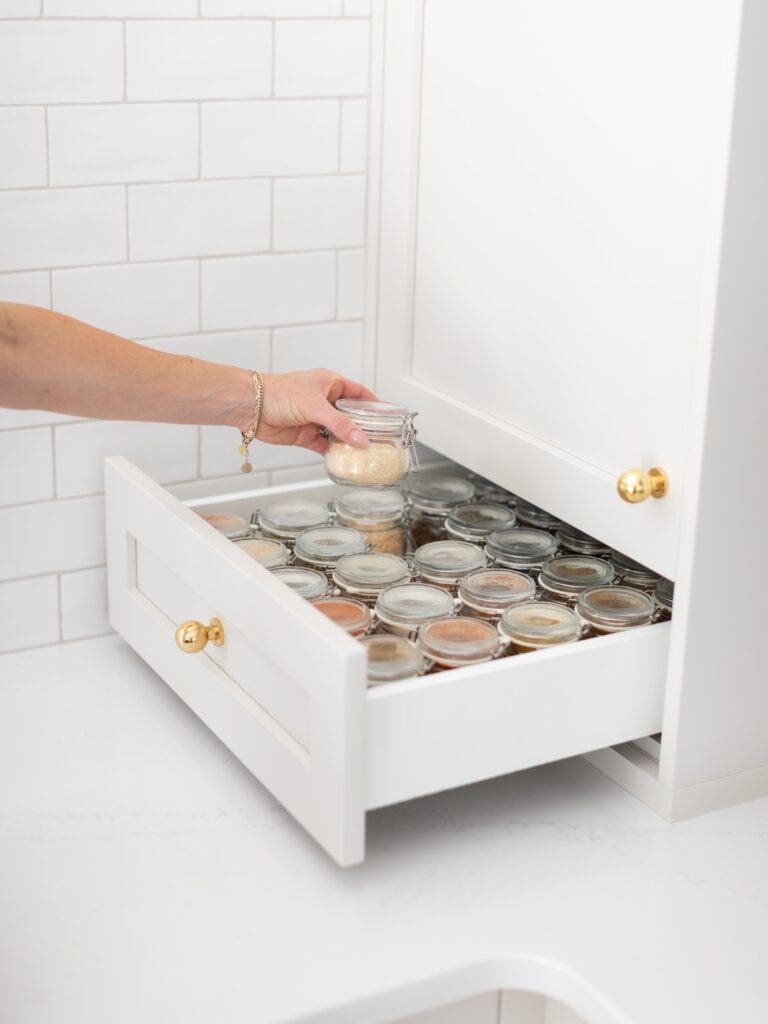
PANTRY ESSENTIALS
Loading up your pantry with staples will help you create healthy meals and recipes in a pinch without unnecessary trips to the grocery store. Whether you are starting from scratch with empty cupboards, or looking for tips for a pantry re-freshy, I’ve made a list of some of the top items I have on hand! The list below is broken down as follows:
LIQUID & FRESH INGREDIENTS
BBQ sauce
A versatile sauce that can be used for tofu, meat or as a base for a pizza topping. Be sure to refrigerate after opening.
Butter (or vegan butter)
I usually use salted butter, but you can use either in these recipes. For vegan butter I prefer the brand Earth Balance. Store in the refrigerator.
Canola or Avocado oil
I like both of these oils due to their neutral flavour and versatility in cooking. They both have a favourable fatty acid profile too making them healthier choices, and can be used for high-heat cooking. Store in the pantry in a sealed container.
Carrots & Celery
They keep for a long time and are very handy to have on hand for quick snacks or an addition to dinner.
Cheese
Parmesan Cheese keeps for ages and adds so much flavour to dishes – a little goes a long way! Parmigiano Reggiano is my favourite. Cheddar is another versatile cheese to keep stocked. Vegan versions of both are available.
Citrus
Lemons and limes are good to have on hand and keep for a long time. I use both the zest and the juice in recipes: you can buy bottled lemon or lime juice but it’s not the same.
Coconut oil
A good replacement for butter (solid at room temperature) in many recipes, coconut oil is a plant-based fat that is rich in saturated fat but adds a lot of flavour to many recipes. Purchase the kind that is solid at room temperature; I prefer organic virgin coconut oil (unrefined). Store in the pantry at room temperature.
Eggs
Free range eggs are preferred. For baking, you can substitute ground flax or ground chia seeds, or semi-firm tofu for things like scrambles if opting for a plant-based substitute.
Garlic
You can buy pre-minced garlic but it doesn’t have the same flavour. To save time purchase peeled garlic cloves that can be crushed.
Ginger
While I prefer to use fresh ginger, jarred ginger will work in a pinch and you may want to keep a jar on hand. Refrigerate after opening.
Greens
Spinach or kale is my go-to. Purchase pre-washed spinach, and for kale, wash it and tear it up (placing it in a sealed container) to make it convenient to throw into salads or smoothies all week long. Either will freeze well.
Honey
A natural sweetener, I recommend purchasing local filtered honey if possible; the recipes here use liquid honey (not creamed). You can substitute maple syrup for honey in most recipes if you wish to make it vegan.
Ketchup
This tomato-based condiment is such a kitchen staple and can be used to add a bit of sweetness and tomato flavour to dishes like soups and stews. Refrigerate after opening.
Maple syrup
Look for 100% pure maple syrup. I buy mine in a can and transfer it to a glass container once opened. Maple syrup must be refrigerated after opening. I use it in baking and of course on pancakes etc.
Mayonnaise
Mayonnaise is a condiment that uses oil as a base. As such, it is rich in fat but the fat is mostly unsaturated! There are many varieties on the market. I personally love the Hellman’s mayonnaise and use the vegan version. Refrigerate mayonnaise after opening.
Milk
I keep a couple of containers of shelf-stable unsweetened oat or soy milk in my pantry for when I need it in a pinch. Store fresh varieties in the fridge along with any opened containers of either type.
Mustard
I recommend stocking both Dijon and yellow mustard. Dijon adds flavour and also acts as an emulsifier in recipes like vinaigrettes. It lasts a long time so is a great pantry staple to always have on hand. Refrigerate after opening.
Nut butters
I recommend keeping natural smooth peanut butter, almond butter and tahini on hand. Stir before using as the oil will settle to the top and store either in the fridge or pantry (will be hard to scoop out if stored in the fridge but will keep for longer).
Olive oil
Probably my favourite oil, olive oil is classified based on the extent of processing. Extra virgin olive oil is what I love using most (contains the most antioxidants and flavour). Don’t cook or bake with olive oil at temperatures over 400 F and note that it is solid when refrigerated. Purchase olive oil in glass containers (dark is preferred to preserve the antioxidants) and store in the pantry.
Onions
Yellow onions are the most versatile and commonly used, but I also recommend keeping red onion on hand.
Pickles
Dill pickles are a must in our house, and are especially amazing added to homemade tartar sauce. Refrigerate after opening.
Potatoes
Red, white, yellow or Russets are all good to have on hand – keep potatoes stored in a dark cool place and scrub them well before using. Do not eat any green parts of the potato.
Red wine vinegar
I love using red wine vinegar in my salad dressings. It can also add a bit of zing to tomato-based dishes like our bolognaise when used in small amounts. Store it in the pantry and discard when the vinegar smells off and has developed a ‘mother’ (sediment that gathers at the bottom).
Rice wine vinegar
Used in a lot of Japanese recipes, this vinegar is delicate and slightly sweet. We love it for quick pickled onions! Store in the pantry.
Sesame oil
This is an oil made from sesame seeds that is popular in Asian cooking. A little goes a long way; it is very flavourful and is often used as a finishing oil (toasted varieties are more flavourful). Since I don’t use it often, I store it in the refrigerator. Look for cold pressed varieties if possible.
Soy sauce
Made from fermented soy beans, soy sauce is a very salty Asian condiment (1 tablespoon = 900mg sodium) that adds a lot of flavour to dishes like stir fries. Use it in moderation and opt for a naturally fermented soy sauce if you can. You can also sub tamari for soy sauce.
Stock
I like to use a stock concentrate (Better than Bouillon is my favourite – some stores carry the vegetarian beef or chicken one that is great) and reconstitute it, but you can also purchase it pre-made in tetras. I like the flexibility that the concentrate gives me and helps reduce waste. Store opened containers of stock or concentrate in the fridge.
Tofu
I prefer to buy extra-firm for my recipes. Look for organic tofu and store in the refrigerator.
Vanilla
Used in a lot of baking, vanilla keeps for a long time and adds a lot of flavour – a must! I like to buy Madagascar vanilla if you can find it but any pure vanilla will work. Store in the pantry.
Yogurt
A good quality full fat plain yogurt (or dairy free version) can be used in sweet (such as smoothies) or savoury recipes.
DRY INGREDIENTS
Baking powder
Used as to leaven (rise) baking (requires a liquid to be activated) store it in the pantry in a sealed container. If you don’t have baking powder you can make your own: combine 1 teaspoon of baking soda with 2 teaspoons of cream of tartar and stir (adjust the quantities as needed, but keep the ratio the same).
Baking soda
Also used to leaven baking, but unlike baking powder, baking soda requires both an acid and a liquid to be activated. It often forms clumps when stored so I recommend sifting it when adding it to a recipe. Store in the pantry in a sealed container. Baking soda also makes a good versatile cleaner for scrubbing sinks etc!
Cocoa powder*
A baking essential, I love the Dutch Processed cocoa (found at many health food or bulk stores) due to its dark colour and richness that it adds to baking but other types of cocoa work well too. Store in a sealed container in the pantry.
Coconut
Look for unsweetened coconut: either shredded or flaked will work equally well in most recipes. Store in a sealed container in the pantry.
Corn Starch
A starch made from corn, it is inexpensive and acts as a thickener with mixed with water and heated (must be boiled for 1-2 minutes to cook the starch out of it). Corn starch also can be added to recipes to give a crisp texture such as baked or fried tofu or chicken fingers.
Crackers
Whole grain crackers make a great snack but can also be crushed up to substitute for bread crumbs in a lot of recipes in a pinch.
Flour
You can use either all-purpose flour or whole wheat flour in most recipes. It is used in a lot of baking recipes and keeps for a long time stored in the pantry in a sealed container. Use a gluten free 1:1 flour mix as a gluten free alternative if needed.
Ground flax (optional)
Ground flax is a plant-based alternative to eggs in many baking recipes, but ground chia will also work.
Nutritional yeast (optional)
Flaked nutritional yeast (aka ‘Nooch’) is a great way to add a cheesy flavour to vegetarian dishes – look for a variety that is fortified with vitamin B12 if you are relying on that for nutrition reasons if you are vegetarian. Note that nutritional yeast is not the same as baking yeast or brewer’s yeast and cannot be used interchangeably.
Nuts
Pecans and raw almonds are the two nuts that I keep stocked in my pantry. They are rich in healthy fats, protein and fibre. I recommend having whole almonds along with sliced or slivered almonds. Store in a tightly sealed container in the pantry.
Oats
I recommend buying large flake oats (aka old-fashioned oats). You can substitute quick oats if you need to, they will just cook quicker and will not have as much texture. Oats are a healthy, fibre-rich grain product and are incredibly versatile. We use them for baked oatmeal, granola and overnight oats. Store in a sealed container in the pantry.
Panko (or bread crumbs)
I prefer Panko (Japanese bread crumbs) over regular bread crumbs, but either will work! Panko gives a crispier finish and should be stored in a sealed package or container in the pantry.
Pasta
I like to keep at least one short shape (like fusilli or penne) and one long shape (like capellini, linguine or spaghetti) on hand at all times along with a package of rice noodles. They can often be used interchangeably in a recipe as long as the shape is similar if you don’t have a variety that is specified, but you will have to adjust the cook time accordingly (reference package instructions). Choose whole grain versions whenever possible.
Pumpkin seeds
One of my favourite seeds, pumpkin seeds are the literally the seeds from the pumpkin. You can use either raw or roasted ones for these recipes though I tend to use raw. Store in the pantry in a sealed container.
Quinoa
A protein-rich and fibre-filled grain, quinoa is also gluten free. It can be made in advance and frozen for future use, and is great used as a base for a stir fry, tossed in a salad or even as a breakfast cereal! Store dried quinoa in the pantry in a sealed container.
Raisins
Such a good ingredient to keep on hand – throw them into oatmeal, granola, overnight oats or baking. I use Thompson raisins but other varieties will work.
Rice
Rice comes in so many different varieties! My favourite is Jasmine rice, but you can use any medium or long grain rice in these recipes. Brown rice is more nutritious than white rice but either will work in these recipes! Brown rice takes longer to cook. Store rice in a sealed container in the pantry.
Sugar
I keep brown sugar and cane sugar on hand – coconut sugar can be substituted in most recipes. Both should be stored in the pantry in a sealed container. To soften hardened brown sugar simply add a slice of bread or apple to the container and let it sit overnight before removing and discarding the apple or bread.
Yeast
Used in baking recipes (ie: bread), I recommend purchasing Active Dry yeast.
Wine
Not a must, but wine can add a lot of flavour to dishes. I recommend keeping a bottle each of good quality (one that you would drink) of white and red wine. You can substitute stock for wine in recipes that call for it! I don’t recommend buying ‘cooking wine’ that you see at the grocery store.
CANNED FOODS
Black beans
We love black beans in many dishes, but mainly Mexican ones. They are such a versatile bean and can be added to salads, tacos or breakfast wraps. Like all beans, are packed with fibre and plant protein. Rinse the beans when you open them before using and store any extras in the fridge in a sealed container. Unopened cans of beans should be stored in the pantry.
Capers
I always have a jar of capers on hand, which are actually edible flower buds from the caper bush that are pickled. I add them to tartar sauce – they are optional but we love them! Store opened jars in the fridge.
Chickpeas
Chickpeas are hearty and keep their shape and are great used in salads or roasted for a snack. Canned chickpeas are the quickest and most convenient, but you can purchase them dried and cook your own from scratch. They can also be blended to make a quick hummus. Like all beans, chickpeas are packed with fibre and plant protein. Rinse the beans when you open them before using and store any extras in the fridge in a sealed container. Unopened cans of beans should be stored in the pantry.
Lentils
A nutrition powerhouse, dry lentils don’t take long to cook and don’t require soaking (should you wish to cook from dry), but canned lentils are what we called for in these recipes to help save time. They are rich in protein and fibre, neutral in taste and can add a hearty texture to soups and sauces.
Diced tomatoes
Diced tomatoes are a pantry staple and are an easy way to incorporate tomatoes into cooked dishes in a pinch. We call for large cans of diced tomatoes in these recipes. Buy the best quality you can find and store them in the pantry.
Salsa
A good jar of salsa is a great ingredient to keep on hand for those days where you don’t want to make your own! Refrigerate after opening.
Tomato paste
Tomato paste adds a concentrated tomato flavour to many recipes. You can purchase cans or tubes of tomato paste. I keep both on hand, and when a recipe calls for less than a can of tomato paste, I use the tube to avoid waste. You can refrigerate or freeze any extra opened tomato paste for later use. Unopened cans or tubes can be stored in the pantry.
Tomato sauce*
A good quality tomato sauce (I like the ones in the glass jars) is a great pantry staple to have on hand to add to sautéed veggies and/or ground for a quick meal.
SPICES & HERBS
All spices should be stored in a sealed container in the pantry in a dark cool location. They will lose their taste over time so it is best to buy spices in small quantities.
Salt
Standard table salt can be used for salting water for pasta and other general uses (and everything else), but you can purchase sea salt or Himalayan pink salt for finishing dishes if you wish. Table salt is fortified with iodine which helps protect our population from iodine deficiency since it is such a common ingredient in North American households.
Cajun spice
A blend of many of our favourite spices, Cajun spice typically includes some combination of cayenne, garlic powder, paprika, and pepper.
Chili powder
There are many types of chili powder on the market: we used standard supermarket Mexican chili powder in these recipes.
Cinnamon
My favourite spice, cinnamon is so cozy and is great added to baking or oatmeal. We use it a lot in these recipes.
Cumin
I love ground cumin for Mexican recipes but we also use it in our Lentil Soup – it is very flavourful!
Dried fennel
You can purchase fennel either whole or ground. We call for ground fennel, so if you don’t have a mortar and pestle, I would recommend buying it ground. It is so yummy added to tomato pasta sauces!
Dried oregano
Used in a lot of Italian cooking, oregano is a great herb to have keeps for a long time.
Garlic & Onion powder
Not to be confused with garlic salt, garlic powder is a great way to add extra garlic flavour to many recipes where you don’t want to use fresh garlic (ie: a spice rub or a seasoning mixture). It’s made from crushed dehydrated garlic. The same goes for onion powder! Different from onion salt, onion powder is a great way to incorporate onion flavour in instances where fresh can’t be used.
Paprika
Used in moderation paprika adds a lot of flavour. It is made from dried peppers and comes in many different varieties including sweet, hot and smoked. We use sweet paprika (or just standard paprika if you are looking at a shelf).
Pepper
You can grind your own pepper with a grinder or just use pre-packaged ground pepper. I keep a little vessel of it on my counter to make it easy to use since I use it so often. I use black pepper.
Taco seasoning
You can make your own taco seasoning should you wish (or if you can’t get any) but a store-bought version works too, it’s up to you! Simply mix together 1/4 cup chili powder, 1 tablespoons salt, 1 tablespoon corn starch, 1 tablespoon ground cumin, 1 tablespoon paprika, 2 teaspoons garlic powder and 2 teaspoons dried oregano. Store in a sealed container in the pantry with the rest of your spices.
FROZEN FOODS
Bread
I buy my favourite bread and keep it in the freezer so that I never run out! Always look for whole grain flour as the first ingredient.
Frozen bananas
You can use fresh bananas in these recipes or if you have ripe bananas that you don’t want to throw away simply peel them and freeze them on a baking sheet – store them in a sealed container in the freezer for quick addition to a smoothie or to make banana bread (or baked oatmeal).
Frozen blueberries
Filled with antioxidants, frozen blueberries are a standard! We buy local BC blueberries which are frozen immediately after being picked, retaining more of their nutrients and freshness. Add them to smoothies, muffins or make a healthy crisp out of them (we included a great recipe here!).
Frozen corn
A great staple to keep on hand, we add it into soups or simply serve it as a side. You can often substitute canned corn if you can’t find frozen.
Frozen fish, seafood & meat
Salmon and other white fish comes in individual portions and is a great food to keep in the freezer along with raw shrimp. It is often fresher if purchased that way vs at the grocery counter, depending on how long it has been sitting there. A couple packages of frozen ground meat (chicken, turkey or beef) along with a package of boneless skinless chicken thighs are good to have on hand in the freezer.
Frozen kale
You can freeze your own kale if you can’t find frozen by simply tearing washed kale into small pieces, freezing on a baking sheet and storing in a sealed container or bag in the freezer. It is great for adding into smoothies or pastas.
Frozen peas
Look for petite peas when buying frozen peas for the best quality and sweetness. We add them into soups and pastas or serve them as a side dish. Canned peas are very soft and don’t make a great substitute for frozen.
Frozen pineapple
Such a great ingredient to have on hand, we mostly use this in smoothies. You can freeze your own pineapple if you can’t find frozen. Simply cut the ends, skin and core off of the pineapple, cut it into chunks and freeze it on a baking sheet. Store the cut frozen pineapple in a sealed container.
Veggie ground or tempeh
This keeps frozen and can be pulled out in a pinch for a quick plant-based meal.

